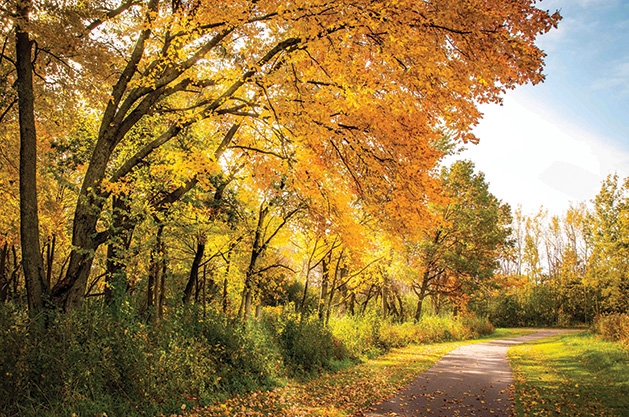
When the city of Woodbury was getting ready to open its new recreation complex, the process of deciding on a name didn't take long. It was an easy decision to name Bielenberg Center for Orville Bielenberg, the city's first mayor, and one of those who helped establish open space preservation for the new city, laying the foundation for today's world-class system of parks and trails, and recreational programs. (The center is now called the HealthEast Sports Center, after a renovation and expansion.)
Most citizens agreed that Bielenberg had done much for the city’s early growth, remembers Dwight Picha, Woodbury's longtime community development director.
Bielenberg was one of a number of city leaders whose foresight has helped Woodbury build one of the best park systems in Minnesota.
The system now consists of approximately 3,300 acres of parks and open spaces, more than 160 miles of trails, 76 athletic courts, 46 play structures and 55 parks overall—plus miscellaneous park buildings.
Bob Klatt, who served as parks director for nearly 35 years until retiring last fall, says city leaders made parks and trails a priority from the time Woodbury was first incorporated. “The city has always had really good leadership at the council and commission level,” Klatt says.
One top priority was preserving as public land the land around each of Woodbury's “not very big” lakes, Klatt notes. Planning started as early as 1971, Klatt says, around Carver Lake, Battle Creek, Wilnes, Powers and other lakes.
One thing that distinguishes Woodbury from many similar suburbs, Klatt says, is that rather than having homes and private lots fronting the lakes, the city mostly has public property and trails around the lakes. Ninety percent of the Woodbury lakeshore is public trails, he notes.
During the late '80s and into the '90s, “the city spent a number of years applying for grants from the state and federal government, to both acquire and develop properties,” Klatt recalls. “I worked on it almost from the day I started and it was almost a 10-year process.”
Not surprisingly, Klatt cites the development of HealthEast Sports Center, considered the city's “crown jewel,” as his other career highlight with the city. For the original Bielenberg facility, after purchasing 80 acres of land to develop baseball-softball and soccer fields and Woodbury's first ice rink, the city passed a $9 million referendum in 1994.
About $6.5 million of that was spent to develop the center, and the rest used to develop a number of neighborhood parks. HealthEast has, for the most part, been a self-supporting facility, Klatt points out, which confirms the city officials' vision. The original air-supported bubble opened in 1995, along with the arena; the fields came online the following year.
Several years ago, the city did a $22 million renovation and expansion, replacing the dome with a larger field house, doubling its size. The arena’s lobby was remodeled, a large outdoor pleasure skating rink was added, and a new 15,000-square-foot accessible playground and splash pad. More fields were added to bring the city's total to 36, for baseball, softball, soccer, lacrosse and football.
According to current parks and recreation director Michelle Okada, the process of strategically watching for available properties that would make good city parks continues. At the same time, the 50-plus-year-old city has moved into a new phase of redeveloping existing parks as needed, as part of maintenance.
Woodbury's newest park is the six-acre Oehlke Park, developed in the Copper Ridge neighborhood on land originally farmed by one of the area's pioneer families, the Oehlkes. The development was started in 2017, around the time Woodbury treasure Mrs. Inez Oehlke passed away.
“The parks, trails and open space system is an integral element in the quality of life for our residents,” Okada notes.









